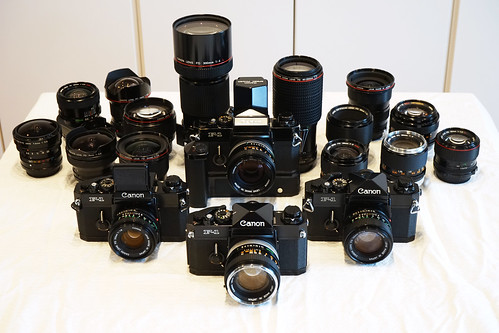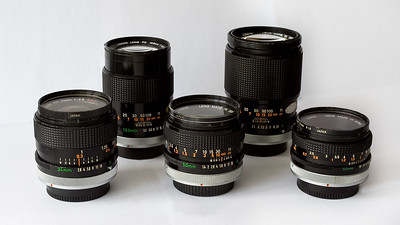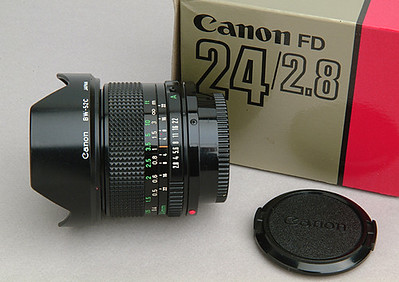Difference between revisions of "Canon FD mount"
m (Added the rare FD 50mm f/2.0, which was a kit lens for Canon's early electronic T series) |
Hanskerensky (talk | contribs) m (→Links: Repaired Link URL) |
||
| (22 intermediate revisions by 6 users not shown) | |||
| Line 1: | Line 1: | ||
| − | + | {{Flickr_image | |
| − | {{ | + | |image_source= https://www.flickr.com/photos/vox/51261256847/in/pool-camerawiki/ |
| − | | image_source= | + | |image= https://live.staticflickr.com/65535/51261256847_9cd3b708f3_w.jpg |
| − | | image= | + | |image_align= right |
| − | | image_align=right | + | |image_text= Diagram of the "new FD" mount<br>from a 1980 Canon ad [https://www.flickr.com/photos/vox/51262183598/in/pool-camerawiki/ listing<br>the FD lenses then available]<br> |
| − | | image_text= | + | |scan_by= Voxphoto |
| + | |image_rights= fair use | ||
}} | }} | ||
| + | === Description === | ||
| + | |||
| + | [[Canon]]'s FD mount replaced the Canon FL mount in 1971 when the company introduced the [[Canon F-1|F-1]] and [[Canon FTb|FTb]]. For the first time, Canon [[SLR]]s offered fully coupled [[open-aperture metering]]. As with the FL mount, original FD lenses are placed against the lens flange without rotation, after which the silver "[[breechlock]]" affixing ring must be rotated to secure the lens. A (mostly theoretical) advantage is that lens and mounting flange never experience any wear from rubbing, maintaining perfect [[flange focal distance]]. | ||
| + | |||
| + | FD lenses have an automatic position on the aperture ring, at first identified by a green circle, later by a green A. Initially only the bulky Servo EE finder for the original [[Canon F-1 | F-1]] supported this, but the [[Canon EF]] soon followed. This support for letting the camera body set the aperture would prove a boon with the arrival of the sales-hit autoexposure [[Canon AE-1]]. | ||
| − | + | In 1976, Canon introduced "New FD" lenses. These offered the convenience of attaching a lens with a one-handed twist (like competing [[bayonet]]-style mounts), while still retaining the same body flange used with earlier breechlock lenses. A clever design allows the inner, mating face of the lens which contains the aperture linkages to remain stationary as the entire outer barrel of the lens rotates around it. (In effect, the whole length of the lens becomes the breechlock fixing ring). | |
| − | In | + | In 1987 the company made a forward-thinking (but painful) move to drop compatibility with the FD mount and move to fully electronic communication with new autofocus [[Canon EF lenses | EF mount lenses]] ("electro focus"—no relation to the EF film SLR).<ref>See a [https://global.canon/en/c-museum/history/eos30th-1.html roundtable reflecting on the new mount] from Canon's official [https://global.canon/en/c-museum/index.html Camera Museum] pages.</ref> |
| + | |||
| + | Some later Sigma FD lenses incorporated a locking version of the breech mount which looked very similar (in style, colour and placement of the locking button) to the release button on New FD lenses. <!--Is there a photo of this? Is this too much of an edge case to be in the intro?--> | ||
| + | {{br}} | ||
== FD Mount Cameras == | == FD Mount Cameras == | ||
| + | {{Flickr_image | ||
| + | |image_source= https://www.flickr.com/photos/huzu1959/14999107214/in/pool-camerawiki | ||
| + | |image= http://farm6.staticflickr.com/5612/14999107214_cfca7e6200.jpg | ||
| + | |image_align= right | ||
| + | |image_text= F-1 (Chrome Nose Type), F-1 with Waist Level Finder,<br>F-1 with Power Winder F and Speed Finder and F-1N | ||
| + | |image_by= Hiroshi Uzu | ||
| + | |image_rights= $ | ||
| + | }} | ||
* [[Canon A-1]] | * [[Canon A-1]] | ||
* [[Canon AE-1]] | * [[Canon AE-1]] | ||
| Line 22: | Line 39: | ||
* [[Canon New F-1|Canon F1(n)]] | * [[Canon New F-1|Canon F1(n)]] | ||
* [[Canon FTb]] | * [[Canon FTb]] | ||
| − | * [[Canon | + | * [[Canon T50]] |
| − | * [[Canon | + | * [[Canon T60]] |
| − | * [[Canon | + | * [[Canon T70]] |
| − | * [[Canon | + | * [[Canon T80]] |
| − | * [[Canon | + | * [[Canon T90]] |
* [[Canon TX]] | * [[Canon TX]] | ||
| + | {{br}} | ||
== FD Mount Lenses == | == FD Mount Lenses == | ||
| + | {|class=floatright | ||
| + | | | ||
| + | {{Flickr image | ||
| + | | image_source=http://www.flickr.com/photos/sixtyfour/3015058713/in/pool-camerawiki | ||
| + | | image=http://farm4.static.flickr.com/3151/3015058713_3c973e0a80_w.jpg | ||
| + | | image_align=right | ||
| + | | image_text=Some original breechlock FD lenses | ||
| + | |image_by= Sixtyfour | ||
| + | |image_rights= with permission | ||
| + | }} | ||
| + | |- | ||
| + | | | ||
| + | {{Flickr_image | ||
| + | |image_source= http://www.flickr.com/photos/90900361@N08/8280501300/in/pool-camerawiki/ | ||
| + | |image= http://farm9.staticflickr.com/8066/8280501300_99226476c6_w.jpg | ||
| + | |image_align= right | ||
| + | |image_text= "new" FD (1976) lacks the silver locking ring | ||
| + | |image_by= Geoff Harrisson | ||
| + | |image_rights= wp | ||
| + | }} | ||
| + | |} | ||
* Canon FD 14mm f/2.8L | * Canon FD 14mm f/2.8L | ||
* Canon FD 15mm f/2.8 | * Canon FD 15mm f/2.8 | ||
| Line 103: | Line 142: | ||
== Adapters == | == Adapters == | ||
| − | The shallow | + | The shallow [[flange focal distance | body depth]] of R, FL and FD mounts makes it easy to mount other manufacturers' lenses using adapters without losing the ability to focus at infinity. This made Canon FD cameras among the most versatile cameras available. An adapter for [[42mm screw lenses | M42]] lenses is particularly handy, as these typically have a switch permitting manual aperture [[stop down]]. |
| − | |||
| − | |||
| + | Conversely, the barrels of Canon FD-mount lenses needed to be longer than those for other film SLR brands. This means, e.g., that users wanting to attach manual-focus Canon glass to modern DSLRs cannot get a mount adapter which allows for infinity focus (unless it contains optics—a weak teleconverter—which may degrade sharpness). Helpfully though, this has somewhat reduced price pressure on used FD-mount lenses, which remain widely available. This may be of interest to [[MILC | digital mirrorless camera]] users (where the shallow flange distance easily allows for FD-lens adapters). | ||
| + | |||
| + | ==Notes== | ||
| + | <references/> | ||
== Links == | == Links == | ||
| − | * Christian Rollinger's [http:// | + | * Christian Rollinger's [http://web.archive.org/web/20090204172942/http://canonfd.com/choose.htm Canon FD Documentation Project] (archived) |
* Photoenthography's [http://www.photoethnography.com/ClassicCameras/Lens-FD.html Canon FD Breechlock lens] page. | * Photoenthography's [http://www.photoethnography.com/ClassicCameras/Lens-FD.html Canon FD Breechlock lens] page. | ||
| − | * Photo.net [ | + | * Photo.net [https://www.photo.net/forums/forum/14-canon-fd-mount/ Canon FD Forum] |
| − | + | * [http://www.cameraquest.com/nikonaf.htm Adapters mounting other lenses on Canon manual-focus bodies] discussed at Stephen Gandy's [http://www.cameraquest.com/ Cameraquest] | |
| + | <!-- * [http://anusf.anu.edu.au/~aab900/photography/cameras/adapters.htm Adapters] to use M42 lenses **2021: LINK GONE BAD? Remove if unable to restore--> | ||
[[Category:Canon FD mount|*]] | [[Category:Canon FD mount|*]] | ||
[[Category:Lens mounts]] | [[Category:Lens mounts]] | ||
Latest revision as of 05:14, 18 April 2023

|
| Diagram of the "new FD" mount from a 1980 Canon ad listing the FD lenses then available scanned by Voxphoto (Image rights) |
Description
Canon's FD mount replaced the Canon FL mount in 1971 when the company introduced the F-1 and FTb. For the first time, Canon SLRs offered fully coupled open-aperture metering. As with the FL mount, original FD lenses are placed against the lens flange without rotation, after which the silver "breechlock" affixing ring must be rotated to secure the lens. A (mostly theoretical) advantage is that lens and mounting flange never experience any wear from rubbing, maintaining perfect flange focal distance.
FD lenses have an automatic position on the aperture ring, at first identified by a green circle, later by a green A. Initially only the bulky Servo EE finder for the original F-1 supported this, but the Canon EF soon followed. This support for letting the camera body set the aperture would prove a boon with the arrival of the sales-hit autoexposure Canon AE-1.
In 1976, Canon introduced "New FD" lenses. These offered the convenience of attaching a lens with a one-handed twist (like competing bayonet-style mounts), while still retaining the same body flange used with earlier breechlock lenses. A clever design allows the inner, mating face of the lens which contains the aperture linkages to remain stationary as the entire outer barrel of the lens rotates around it. (In effect, the whole length of the lens becomes the breechlock fixing ring).
In 1987 the company made a forward-thinking (but painful) move to drop compatibility with the FD mount and move to fully electronic communication with new autofocus EF mount lenses ("electro focus"—no relation to the EF film SLR).[1]
Some later Sigma FD lenses incorporated a locking version of the breech mount which looked very similar (in style, colour and placement of the locking button) to the release button on New FD lenses.
FD Mount Cameras

|
| F-1 (Chrome Nose Type), F-1 with Waist Level Finder, F-1 with Power Winder F and Speed Finder and F-1N image by Hiroshi Uzu (Image rights) |
- Canon A-1
- Canon AE-1
- Canon AE-1 Program
- Canon AL-1
- Canon AT-1
- Canon AV-1
- Canon EF
- Canon F-1
- Canon F1(n)
- Canon FTb
- Canon T50
- Canon T60
- Canon T70
- Canon T80
- Canon T90
- Canon TX
FD Mount Lenses
| ||
|
- Canon FD 14mm f/2.8L
- Canon FD 15mm f/2.8
- Canon FD 17mm f/4.0
- Canon FD 20mm f/2.8
- Canon FD 24mm f/1.4L
- Canon FD 24mm f/2.0
- Canon FD 24mm f/2.8
- Canon FD 28mm f/2.0
- Canon FD 28mm f/2.8
- Canon FD 28mm f/3.5
- Canon FD 35mm f/2.0
- Canon FD 35mm f/2.8
- Canon FD 35mm f/3.5
- Canon FD 50mm f/1.2L
- Canon FD 50mm f/1.2
- Canon FD 50mm f/1.4
- Canon FD 50mm f/1.8
- Canon FD 50mm f/2.0
- Canon FD 50mm f/3.5 Macro
- Canon FD 85mm f/1.2L
- Canon FD 85mm f/1.8
- Canon FD 100mm f/2.0
- Canon FD 100mm f/2.8
- Canon FD 100mm f/4.0 Macro
- Canon FD 135mm f/2.0
- Canon FD 135mm f/2.5
- Canon FD 135mm f/2.8
- Canon FD 135mm f/3.5
- Canon FD 200mm f/1.8L
- Canon FD 200mm f/2.8
- Canon FD 200mm f/4.0
- Canon FD 200mm f/4.0 Macro
- Canon FD 300mm f/5.6
- Canon FD 300mm f/4.0
- Canon FD 300mm f/4.0L
- Canon FD 300mm f/2.8
- Canon FD 400mm f/4.5
- Canon FD 400mm f/2.8L
- Canon FD 500mm f/4.5L
- Canon FD 500mm f/8
- Canon FD 600mm f/4.5
- Canon FD 800mm f/5.6
- Canon FD 800mm f/5.6L
EXTENDERS
- Canon FD 1.4X-A
- Canon FD 2X-A
- Canon FD 2X-b
ZOOMS
- Canon FD 20-35mm f/3.5L
- Canon FD 24-35mm f/3.5L
- Canon FD 28-50mm f/3.5
- Canon FD 28-55mm f/3.5-4.5
- Canon FD 28-85mm f/4.0
- Canon FD 35-70mm f/2.8-3.5
- Canon FD 35-70mm f/3.5-4.5
- Canon FD 35-70mm f/4.0
- Canon FD 35-70mm f/4.0 AF
- Canon FD 35-105mm f/3.5
- Canon FD 35-105mm f/3.5-4.5
- Canon FD 50-135mm f/3.5
- Canon FD 50-300mm f/4.5L
- Canon FD 70-150mm f/4.5
- Canon FD 70-210mm f/4.0
- Canon FD 75-200mm f/4.5
- Canon FD 80-200mm f/4.0
- Canon FD 80-200mm f/4.0L
- Canon FD 85-300mm f/4.5
- Canon FD 100-200mm f/5.6
- Canon FD 100-300mm f/5.6
- Canon FD 100-300mm f/5.6L
- Canon FD 150-600mm f/5.6L
Adapters
The shallow body depth of R, FL and FD mounts makes it easy to mount other manufacturers' lenses using adapters without losing the ability to focus at infinity. This made Canon FD cameras among the most versatile cameras available. An adapter for M42 lenses is particularly handy, as these typically have a switch permitting manual aperture stop down.
Conversely, the barrels of Canon FD-mount lenses needed to be longer than those for other film SLR brands. This means, e.g., that users wanting to attach manual-focus Canon glass to modern DSLRs cannot get a mount adapter which allows for infinity focus (unless it contains optics—a weak teleconverter—which may degrade sharpness). Helpfully though, this has somewhat reduced price pressure on used FD-mount lenses, which remain widely available. This may be of interest to digital mirrorless camera users (where the shallow flange distance easily allows for FD-lens adapters).
Notes
- ↑ See a roundtable reflecting on the new mount from Canon's official Camera Museum pages.
Links
- Christian Rollinger's Canon FD Documentation Project (archived)
- Photoenthography's Canon FD Breechlock lens page.
- Photo.net Canon FD Forum
- Adapters mounting other lenses on Canon manual-focus bodies discussed at Stephen Gandy's Cameraquest

